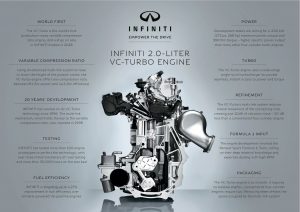Nissan Introduces Variable Compression Ratio Engine in 2019 Infiniti QX50
Too often at auto shows the external hardware of the car gets all the attention, when we know its what’s under the hood that counts. At the recent Los Angeles Auto Show, Nissan introduced a break-through engine technology that shows great potential to improve the efficiency and power of current engines—variable compression.

This is not some science experiment. The engine will debut in the 2019 Infiniti QX50, which will arrive in 2018. To illustrate the dramatic change possible with this technology:
- It will arrive in a 2.0-liter turbocharged four-cylinder that will replace a 3.7-liter V-6
- The new engine will have a 27 percent fuel economy boost compared to the old one.
- The new engine will deliver 268 horsepower and 288 pounds-feet of torque, resulting in 0-60 acceleration one seconds faster than competitors.
- Early reports from press drives of early pilot-builds of the QX50 with the new engine said it was “impressive” in both power and refinement—and it was transparent to the drive.
What It Does
Nissan said it has been working on variable compression technology for 20 years, piling up more than 300 patented technologies along the way. Formula 1 racers even played a role in the engine development.
Until this engine, all pistons traveled the same distance up and down in their cylinders, whatever speed and load the vehicle they were tasked with motivating had. The compression ratio of an engine is determined by the amount of space (smaller spaces lead to higher compression) left at the top of a piston’s travel. That is the way it’s been forever.
The pistons in the VC-Turbo (Nissan’s name for the QX50 engine) are connected to rods that are attached to one end of an elliptic device Nissan calls a multi-link, which replaces the normal connecting rod connection on the crankshaft. An electrically controlled actuator twists a shaft, which causes the multi-link to tilt up or down slightly. Depending on the tilt angle, the compression ratio goes up or down.
The compression ratio varies from 8:1 to 14:1. The engine’s turbocharger kicks in to boost power with the lower ratio, while the higher compression ratio approaches that of a diesel engine and the efficiency it brings.

As with many recent engine advances, Nissan chief powertrain engineer, Shinichi Kiga, told reporters that modern engine control technologies were the key to getting this engine into production. In addition to the turbocharger, it features both port and direct fuel injection, variable valve timing and a cooling system with four circuits. The computer brain runs the show and tells the actuator when to spin.
The Bottom Line
Nissan said the engine is more expensive than conventional ones, but only about 10 percent more, so the increased fuel economy should bring payback relatively quickly. The engine, mated to a continuously variable transmission, will be the only one offered in the new QX50. It will require premium fuel.

The bigger question is where the technology might end up next as Nissan seeks to amortize the development cost by bumping up production. The company touts it as a lower cost route to diesel power and fuel efficiency, which might point the engine toward use in its larger vehicles.
Assuming the durability of the system is solid, which 20 years of development should assure, logically the engines may start showing up in larger, heavier vehicles. With those, a six mpg fuel economy improvement is quite an achievement, and its low cost creates an even steeper hurdle for electric drive to overcome.
To echo Mark Twain’s remarks, recent pronouncements of the death of the internal combustion engine may have been premature.

5 thoughts on “Tech: Engine Variable Compression Gamechanger”